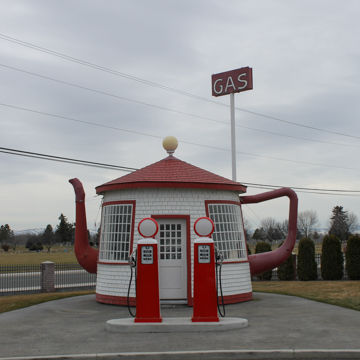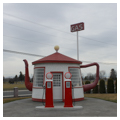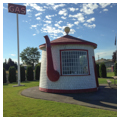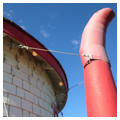The Teapot Dome Service Station in Zillah is a commercial monument to one of the most damaging but little remembered political scandals in American history: the Teapot Dome Scandal, which tainted the Warren G. Harding administration and resulted in criminal charges against Albert B. Fall, the Secretary of the Interior. Built and marketed by local resident Jack Ainsworth during the early 1920s, what became a roadside attraction was designed as a protest against illegal oil leases and political graft while capitalizing on the scandal’s fame—all to sell petroleum. The gas station, located 20 miles southeast of Yakima, nonetheless remained in operation for approximately 90 years until its relocation to its present site and reconstitution as a museum in 2012. During that period, it was the longest continually operating gas station in America.
The circular frame building, designed in the shape of a teapot and clad in wood shingles, is 14-feet in diameter and has a 10-foot-high ceiling, with two large, multipaned windows flanking a single-leaf door featuring a 20-paned glazed panel. Today the interior is an undivided space with a plywood wall and floor, and the roof, with projecting eaves and exposed rafters, is crowned with a glass globe and a flashing light. A sheet metal “handle” extending from one side of the building is purely decorative, while a concrete “spout,” extending from the opposite side, functions as a stovepipe in cold weather. Gas pumps, now replaced with vintage replicas, originally served motorists just outside the front door, and a tall, freestanding nearby sign with the word “gas” hoped to garner drivers’ attention along the highway. These features came together in an unusual roadside attraction whose first location was along U.S. Highway 410 between Zillah and Granger. Prior to the completion of I-82, this was a principal highway in east-central Washington.
The early days of automobile culture in America were accompanied by a diversity of commercial markers intended to catch the motorist’s eye—including the larger “Bob’s Java Jive” in Tacoma (designed in the shape of a coffee pot in 1927) and two milk bottle–shaped structures for the Benewah Dairy Company in Spokane in 1935—but very few of them used political protest as means of luring customers. Ainsworth specifically intended the building to lampoon the Harding administration over the bribery scandal involving gas leases to the Teapot Dome Navy Petroleum Reserves in Wyoming (so named because the rock formation resembled a teapot). The political context of the Teapot Dome Service Station, despite lacking a direct connection to Washington or the Pacific Northwest, adds an additional level of significance beyond its function as a commercial enterprise and early roadside attraction.
Ainsworth built the structure in the midst of the scandal and operated it until 1928, when he sold it to A.J. Thomas and his wife, who continued the station as a family operation until 1989. Under the ownership of the Thomas family in 1978, the structure was moved to make way for the construction of I-82. However, a car hit the station just five days before the move, resulting in significant damage. With help from the Washington State Department of Transportation, the Thomas family restored the structure and moved it to the nearby Yakima Valley Highway. Lyn Dasso purchased it in 1989 and continued to operate the gas station until 2007, when the city of Zillah purchased it and moved it once again—this time to its current location on First Avenue. Following a city-funded restoration, which included the addition of the two non-operating vintage gas pumps, the Teapot Dome Service Station now functions as a visitor center and museum, a remnant of the commercial roadside vernacular of the 1920s, and a reminder of an American political scandal that might otherwise be relegated to the annals of history.
References
“Teapot.” City of Zillah. Accessed December 29, 2014. http://www.cityofzillah.us/.
Thomas, Richard L., “Teapot Dome Service Station,” Yakima County, Washington. National Register of Historic Places Inventory–Nomination Form, 1972. National Park Service, U.S. Department of the Interior, Washington D.C.

















